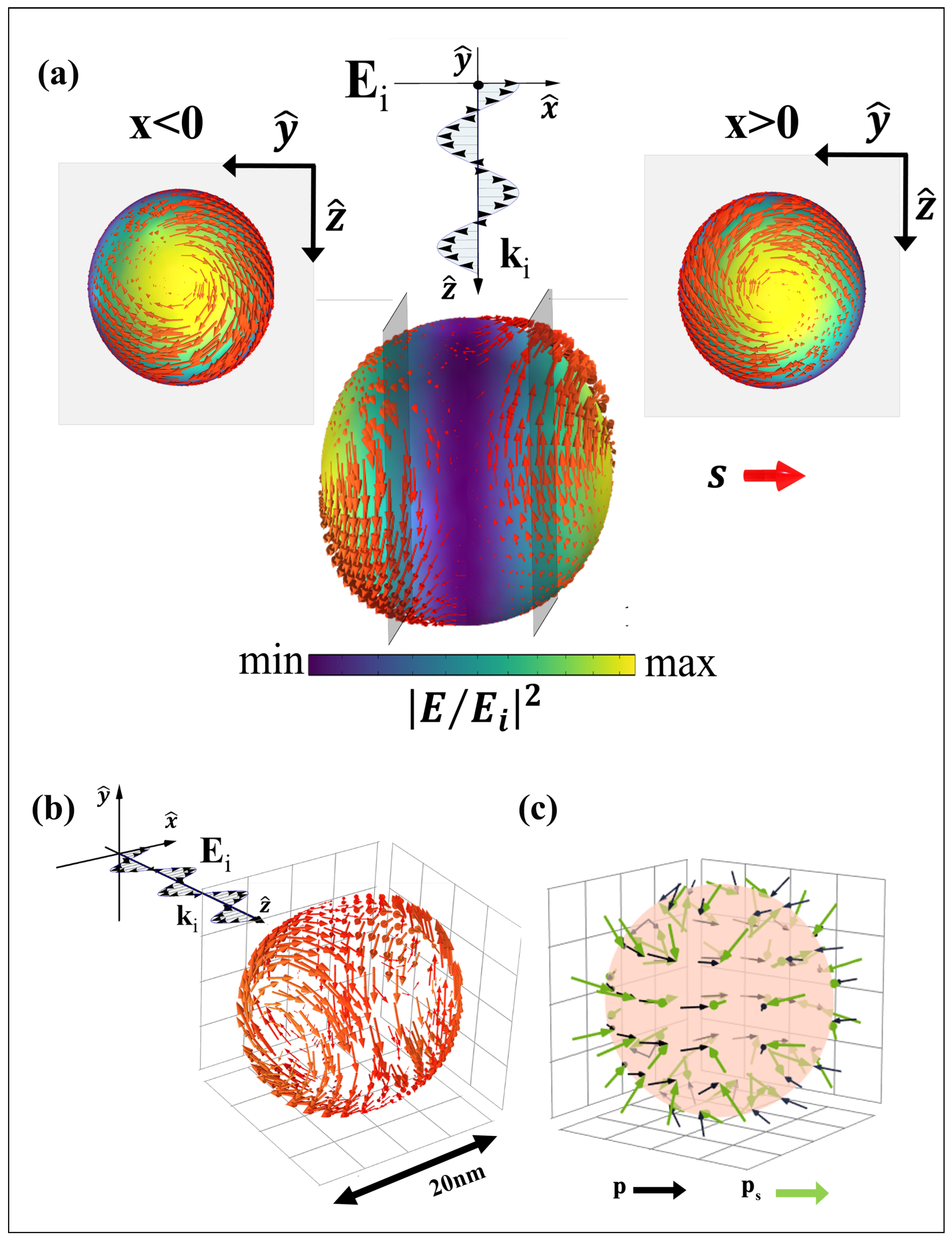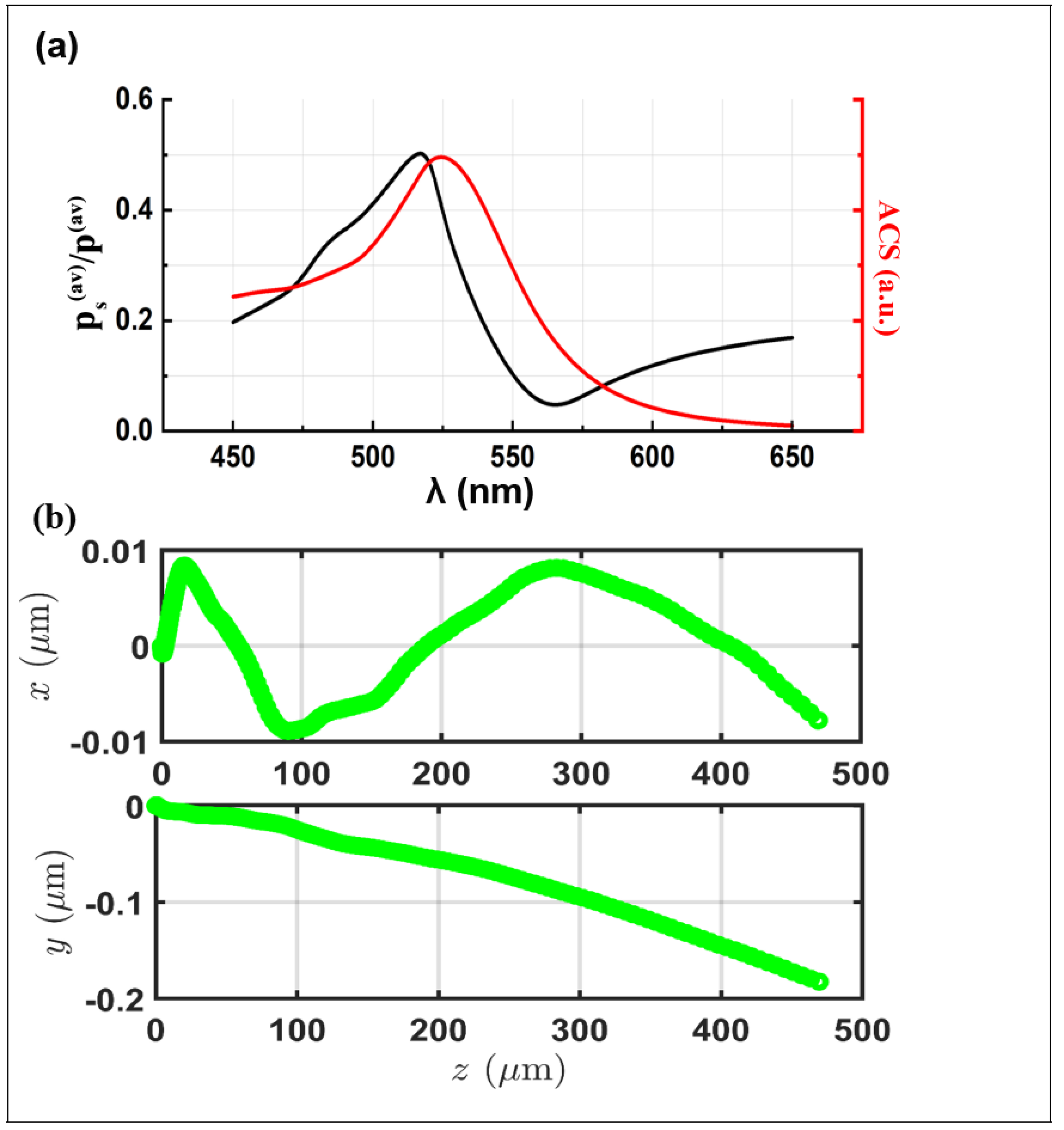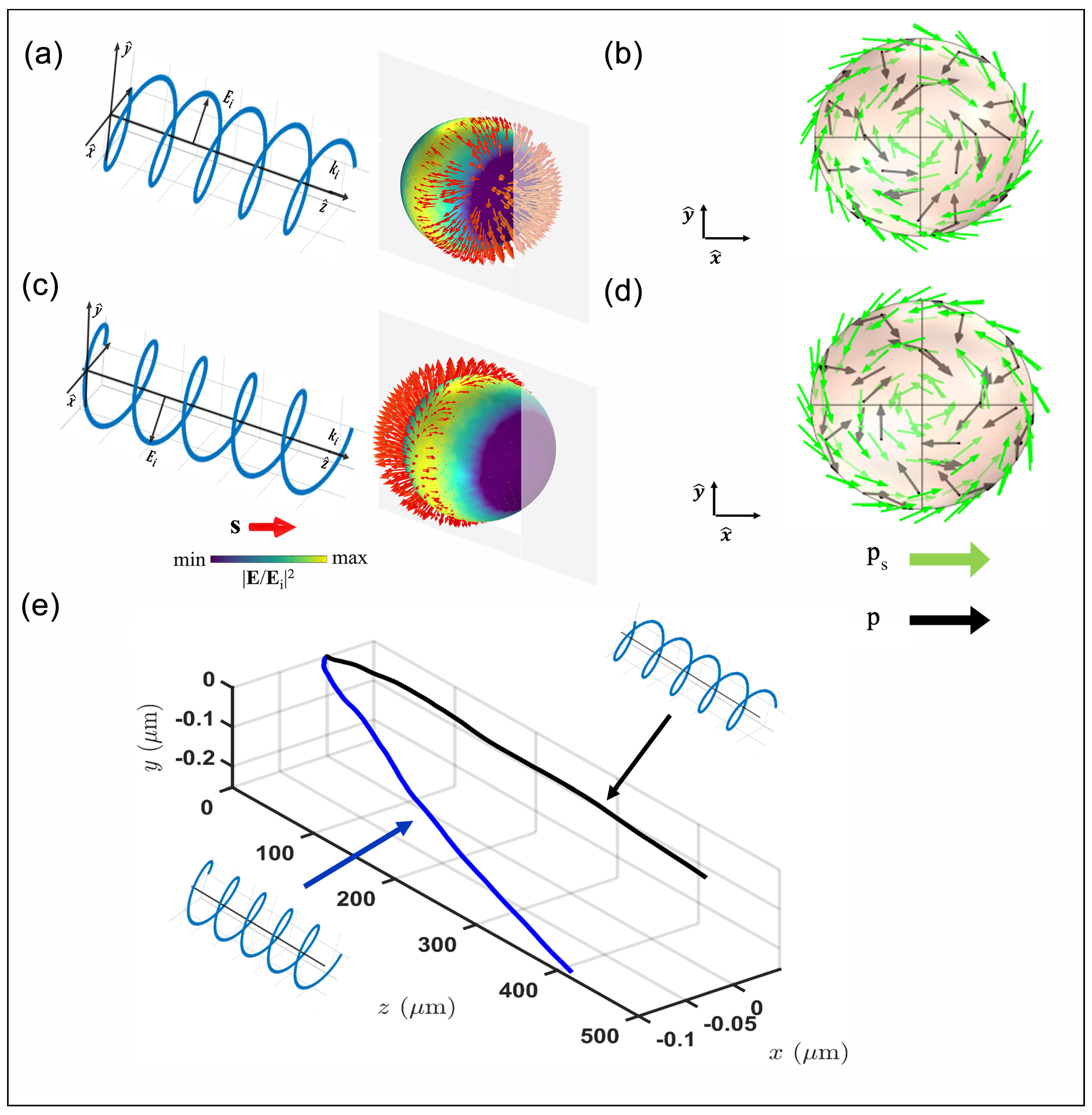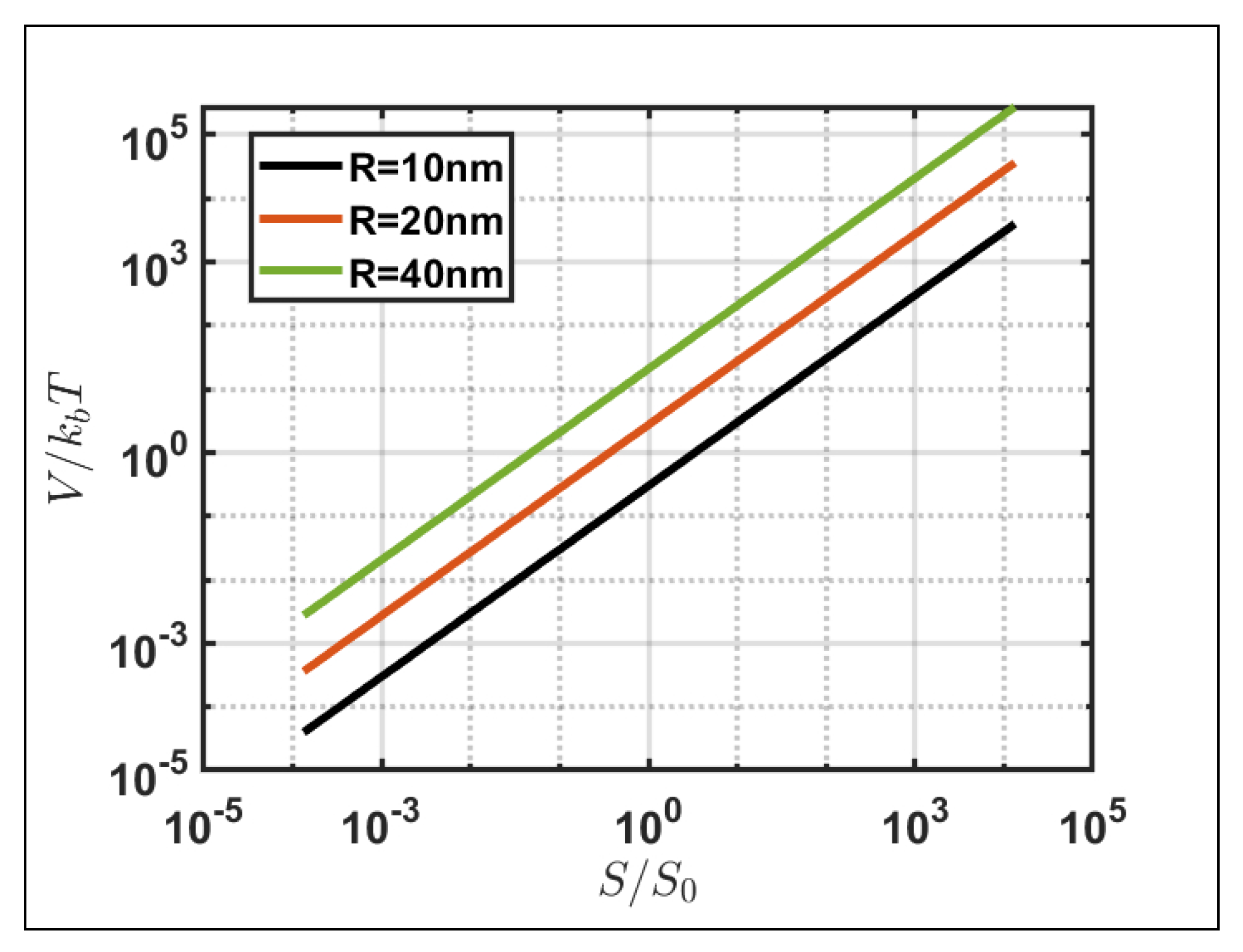Polarization-Addressable Optical Movement of Plasmonic Nanoparticles and Hotspot Spin Vortices
Abstract
:1. Introduction
2. Materials and Methods
- Force evaluation, via Maxwell Tensor, using COMSOL v.6.2 Simulation of the model;
- Force result processed in MATLAB v.2023b and evaluation of dynamics result (speed and position) using the motion equation; the time step of the dynamics is imposed previously ( s);
- The new position of the gold nanoparticle is added in the FEM model for a new COMSOL v.6.2 evaluation of the optical force;
- The cycle is repeated.
3. Results
3.1. Trajectories of Gold Monomers
- A helicity-independent contribution, derived from the tSAM, affecting the trajectory variation along the y axis for both polarizations;
- A helicity-dependent contribution prompting a trajectory shift along the x axis, the orientation being determined by the incident helicity.
3.2. Spin Momentum in Plasmonic Dimer
4. Discussion
5. Conclusions
- In the single-particle case, we observed spin distribution tangential to the plane orthogonal to the direction of polarization of the incident field, resulting in the formation of a vortex and an anti-vortex due to the symmetry of the system.
- In a plasmonic dimer, the light forms a vortex and an anti-vortex within the gap only in some polarizations. The intensities depend on the gap and the polarization used; these two vortices collapse at the center, forming a spin singularity.
- The dynamics of the resonant nanoparticles (single and dimer cases) exhibited deviations induced by the transverse spin momentum depending on the incident polarization.
Author Contributions
Funding
Data Availability Statement
Conflicts of Interest
Abbreviations
| SAM | Spin angular momentum |
| tSAM | Transverse spin angular momentum |
| FEM | Finite element method |
| LSP | Localized surface plasmon |
| LSPR | Localized surface plasmon resonance |
| OAM | Orbital angular momentum |
| ACS | Absorption cross section |
| RCP | Right circular polarization |
| LCP | Left circular polarization |
| SPP | Surface plasmon polaritons |
| SOI | Spin–orbit interaction |
References
- Bliokh, K.Y.; Rodríguez-Fortuño, F.J.; Nori, F.; Zayats, A.V. Spin-orbit interactions of light. Nat. Photonics 2015, 9, 796–808. [Google Scholar] [CrossRef]
- Bliokh, K.Y.; Nori, F. Transverse and longitudinal angular momenta of light. Phys. Rep. 2015, 592, 1–38. [Google Scholar] [CrossRef]
- Ciattoni, A.; Cincotti, G.; Palma, C. Angular momentum dynamics of a paraxial beam in a uniaxial crystal. Phys. Rev. E 2003, 67, 036618. [Google Scholar] [CrossRef] [PubMed]
- Zel’Dovich, B.Y.; Kundikova, N.; Rogacheva, L. Observation of transverse shift of a focal spot upon a change in the sign of circular polarization. ZhETF Pisma Redaktsiiu 1994, 59, 737. [Google Scholar]
- Schwartz, C.; Dogariu, A. Conservation of angular momentum of light in single scattering. Opt. Express 2006, 14, 8425–8433. [Google Scholar]
- Bliokh, K.Y.; Samlan, C.; Prajapati, C.; Puentes, G.; Viswanathan, N.K.; Nori, F. Spin-Hall effect and circular birefringence of a uniaxial crystal plate. Optica 2016, 3, 1039–1047. [Google Scholar] [CrossRef]
- De Tommasi, E.; Romano, S.; Mocella, V.; Sgrignuoli, F.; Lanzio, V.; Cabrini, S.; Zito, G. Half-Integer Topological Charge Polarization of Quasi-Dirac Bound States in the Continuum. Adv. Opt. Mater. 2023, 11, 2300475. [Google Scholar] [CrossRef]
- Bokor, N.; Iketaki, Y.; Watanabe, T.; Fujii, M. Investigation of polarization effects for high-numerical-aperture first-order Laguerre-Gaussian beams by 2D scanning with a single fluorescent microbead. Opt. Express 2005, 13, 10440–10447. [Google Scholar] [CrossRef] [PubMed]
- Zhao, Y.; Edgar, J.S.; Jeffries, G.D.; McGloin, D.; Chiu, D.T. Spin-to-orbital angular momentum conversion in a strongly focused optical beam. Phys. Rev. Lett. 2007, 99, 073901. [Google Scholar] [CrossRef]
- Bliokh, K.Y.; Ostrovskaya, E.A.; Alonso, M.A.; Rodríguez-Herrera, O.G.; Lara, D.; Dainty, C. Spin-to-orbital angular momentum conversion in focusing, scattering, and imaging systems. Opt. Express 2011, 19, 26132–26149. [Google Scholar] [CrossRef]
- Onoda, M.; Murakami, S.; Nagaosa, N. Hall effect of light. Phys. Rev. Lett. 2004, 93, 083901. [Google Scholar] [CrossRef]
- Hosten, O.; Kwiat, P. Observation of the spin Hall effect of light via weak measurements. Science 2008, 319, 787–790. [Google Scholar] [CrossRef] [PubMed]
- Bliokh, K.Y.; Smirnova, D.; Nori, F. Quantum spin Hall effect of light. Science 2015, 348, 1448–1451. [Google Scholar] [CrossRef] [PubMed]
- Bliokh, K.Y.; Bekshaev, A.Y.; Nori, F. Extraordinary momentum and spin in evanescent waves. Nat. Commun. 2014, 5, 3300. [Google Scholar] [CrossRef] [PubMed]
- Antognozzi, M.; Bermingham, C.; Harniman, R.; Simpson, S.; Senior, J.; Hayward, R.; Hoerber, H.; Dennis, M.; Bekshaev, A.; Bliokh, K.; et al. Direct measurements of the extraordinary optical momentum and transverse spin-dependent force using a nano-cantilever. Nat. Phys. 2016, 12, 731–735. [Google Scholar] [CrossRef]
- O’connor, D.; Ginzburg, P.; Rodríguez-Fortuño, F.J.; Wurtz, G.A.; Zayats, A.V. Spin–orbit coupling in surface plasmon scattering by nanostructures. Nat. Commun. 2014, 5, 5327. [Google Scholar] [CrossRef] [PubMed]
- Shi, Y.; Zhu, T.; Liu, J.; Tsai, D.P.; Zhang, H.; Wang, S.; Chan, C.T.; Wu, P.C.; Zayats, A.V.; Nori, F.; et al. Stable optical lateral forces from inhomogeneities of the spin angular momentum. Sci. Adv. 2022, 8, eabn2291. [Google Scholar] [CrossRef] [PubMed]
- Petersen, J.; Volz, J.; Rauschenbeutel, A. Chiral nanophotonic waveguide interface based on spin-orbit interaction of light. Science 2014, 346, 67–71. [Google Scholar] [CrossRef] [PubMed]
- Kerber, R.; Fitzgerald, J.; Xiao, X.; Oh, S.S.; Maier, S.; Giannini, V.; Reiter, D. Interaction of an Archimedean spiral structure with orbital angular momentum light. New J. Phys. 2018, 20, 095005. [Google Scholar] [CrossRef]
- Liaw, J.W.; Huang, M.C.; Chao, H.Y.; Kuo, M.K. Spin and orbital rotation of plasmonic dimer driven by circularly polarized light. Nanoscale Res. Lett. 2018, 13, 322. [Google Scholar] [CrossRef]
- Zaman, M.A.; Padhy, P.; Hesselink, L. Solenoidal optical forces from a plasmonic Archimedean spiral. Phys. Rev. A 2019, 100, 013857. [Google Scholar] [CrossRef] [PubMed]
- Revah, M.; Yaroshevsky, A.; Gorodetski, Y. Spin-locking metasurface for surface plasmon routing. Sci. Rep. 2019, 9, 8963. [Google Scholar] [CrossRef] [PubMed]
- Huang, L.; Chen, X.; Bai, B.; Tan, Q.; Jin, G.; Zentgraf, T.; Zhang, S. Helicity dependent directional surface plasmon polariton excitation using a metasurface with interfacial phase discontinuity. Light. Sci. Appl. 2013, 2, e70. [Google Scholar] [CrossRef]
- Li, S.; Li, X.; Wang, G.; Liu, S.; Zhang, L.; Zeng, C.; Wang, L.; Sun, Q.; Zhao, W.; Zhang, W. Multidimensional manipulation of photonic spin Hall effect with a single-layer dielectric metasurface. Adv. Opt. Mater. 2019, 7, 1801365. [Google Scholar] [CrossRef]
- Angelsky, O.V.; Zenkova, C.Y.; Hanson, S.G.; Zheng, J. Extraordinary manifestation of evanescent wave in biomedical application. Front. Phys. 2020, 8, 159. [Google Scholar] [CrossRef]
- Zhang, Q.; Li, J.; Liu, X. Optical lateral forces and torques induced by chiral surface-plasmon-polaritons and their potential applications in recognition and separation of chiral enantiomers. Phys. Chem. Chem. Phys. 2019, 21, 1308–1314. [Google Scholar] [CrossRef] [PubMed]
- Triolo, C.; Cacciola, A.; Patanè, S.; Saija, R.; Savasta, S.; Nori, F. Spin-momentum locking in the near field of metal nanoparticles. ACS Photonics 2017, 4, 2242–2249. [Google Scholar] [CrossRef]
- Belinfante, F.J. On the current and the density of the electric charge, the energy, the linear momentum and the angular momentum of arbitrary fields. Physica 1940, 7, 449–474. [Google Scholar] [CrossRef]
- Grier, D.G. A revolution in optical manipulation. Nature 2003, 424, 810–816. [Google Scholar] [CrossRef] [PubMed]
- Meinzer, N.; Barnes, W.L.; Hooper, I.R. Plasmonic meta-atoms and metasurfaces. Nat. Photonics 2014, 8, 889–898. [Google Scholar] [CrossRef]
- Balestrieri, S.; Zito, G.; Coppola, G.; Iodice, M. Plasmonic Nanostructures for optically induced movement. Front. Nanotechnol. 2022, 4, 886636. [Google Scholar] [CrossRef]
- Shalin, A.S.; Sukhov, S.V. Plasmonic nanostructures as accelerators for nanoparticles: Optical nanocannon. Plasmonics 2013, 8, 625–629. [Google Scholar] [CrossRef]
- Balestrieri, S.; Zito, G.; Iodice, M.; Coppola, G. Optimized array nanostructure for plasmonically induced motion force generation. Opt. Express 2023, 31, 33945–33962. [Google Scholar] [CrossRef] [PubMed]
- Maier, S.A. Plasmonics: Fundamentals and Applications; Springer: Berlin/Heidelberg, Germany, 2007; Volume 1. [Google Scholar]
- Miljkovic, V.D.; Pakizeh, T.; Sepulveda, B.; Johansson, P.; Kall, M. Optical forces in plasmonic nanoparticle dimers. J. Phys. Chem. C 2010, 114, 7472–7479. [Google Scholar] [CrossRef]
- Johnson, P.B.; Christy, R.W. Optical constants of the noble metals. Phys. Rev. B 1972, 6, 4370. [Google Scholar] [CrossRef]
- Sommerfeld, A. Partial Differential Equations in Physics; Academic Press: Cambridge, MA, USA, 1949. [Google Scholar]
- Novotny, L.; Hecht, B. Principles of Nano-Optics; Cambridge University Press: Cambridge, UK, 2012. [Google Scholar]
- Jackson, J.D. Classical Electrodynamics; Springer International Publishing: Cham, Switzerland, 1999. [Google Scholar]
- Neugebauer, M.; Banzer, P.; Nechayev, S. Emission of circularly polarized light by a linear dipole. Sci. Adv. 2019, 5, eaav7588. [Google Scholar] [CrossRef] [PubMed]
- Khodas, M.; Shekhter, A.; Finkel’Stein, A. Spin polarization of electrons by nonmagnetic heterostructures: The basics of spin optics. Phys. Rev. Lett. 2004, 92, 086602. [Google Scholar] [CrossRef] [PubMed]
- Volpe, G.; Volpe, G. Simulation of a Brownian particle in an optical trap. Am. J. Phys. 2013, 81, 224–230. [Google Scholar] [CrossRef]
- Zaman, M.A.; Wu, M.; Padhy, P.; Jensen, M.A.; Hesselink, L.; Davis, R.W. Modeling brownian microparticle trajectories in lab-on-a-chip devices with time varying dielectrophoretic or optical forces. Micromachines 2021, 12, 1265. [Google Scholar] [CrossRef]







Disclaimer/Publisher’s Note: The statements, opinions and data contained in all publications are solely those of the individual author(s) and contributor(s) and not of MDPI and/or the editor(s). MDPI and/or the editor(s) disclaim responsibility for any injury to people or property resulting from any ideas, methods, instructions or products referred to in the content. |
© 2024 by the authors. Licensee MDPI, Basel, Switzerland. This article is an open access article distributed under the terms and conditions of the Creative Commons Attribution (CC BY) license (https://creativecommons.org/licenses/by/4.0/).
Share and Cite
Balestrieri, S.; Romano, S.; Iodice, M.; Coppola, G.; Zito, G. Polarization-Addressable Optical Movement of Plasmonic Nanoparticles and Hotspot Spin Vortices. Nanomaterials 2024, 14, 829. https://doi.org/10.3390/nano14100829
Balestrieri S, Romano S, Iodice M, Coppola G, Zito G. Polarization-Addressable Optical Movement of Plasmonic Nanoparticles and Hotspot Spin Vortices. Nanomaterials. 2024; 14(10):829. https://doi.org/10.3390/nano14100829
Chicago/Turabian StyleBalestrieri, Sergio, Silvia Romano, Mario Iodice, Giuseppe Coppola, and Gianluigi Zito. 2024. "Polarization-Addressable Optical Movement of Plasmonic Nanoparticles and Hotspot Spin Vortices" Nanomaterials 14, no. 10: 829. https://doi.org/10.3390/nano14100829





